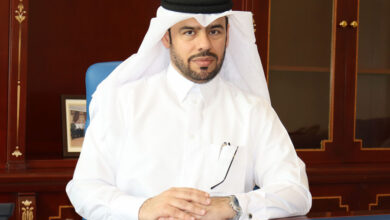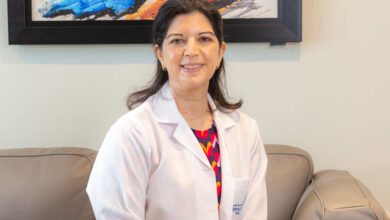Dr. Colin Fincham
Senior Director & Chief Medical Officer, Cerner EMEA, LATAM and Canada
Dr. Colin Fincham
“CERNER BELIEVES THAT ONE OF THE PILLARS FOR BUILDING A HEALTHIER POPULATION IS THROUGH TECHNOLOGY”

Cerner, one of the leading companies in healthcare information technology, has been working for 40 years to make healthcare safer and more efficient. It uses the latest technology to create solutions that let communities and people engage in their own health. “Hospitals” magazine had the privilege to meet with Dr. Colin Fincham, Senior Director & Chief Medical Officer, Cerner EMEA, LATAM and Canada to discuss the company’s strategies, the steps to enhance the integration between healthcare and technology among others. Below is the full interview:
It is well known that Cerner creates solutions that make communities and people engage in their own health. Can you introduce our readers to the strategies that you follow to implement them?
The best way to explain Cerner’s approach to helping communities and citizens get more engaged in their own health is by giving a couple of examples of where we have worked with our partners to deliver outcomes.
The first example I would give is that of the Wirral peninsula, an area in the North West of England, which has a significant health discrepancy. On the east side is Birkenhead, the third-worst area for health inequalities in the UK, and on the west side is Heswell, which is one of the most affluent areas – the seven-mile, 20-minute drive between the two encompasses a 12-year difference in life expectancy. Cerner worked with the hospital, community, mental health and primary care providers to tackle this.
The first fundamental question to answer is “what matters to you?”, rather than the normal medical question “what is the matter with you?”. Some of the fundamental answers included integrated, joined up services, accessibility, use of community resources. We then worked with all the agencies to identify the best citizen-centered approach. This method was founded around Cerner’s proven methodology of ‘Know, Engage, Manage’.
- Know: Identifying and predicting what will happen within the population
- Engage: Encouraging people, their family and care providers to take action
- Manage: Managing outcomes to improve health and care
Cerner works with our clients as partners to understand the needs of the patient, citizen and users of the system in delivering the appropriate solutions depending on the situation and challenge the client is undertaking.
Firstly, knowing the citizens, and their needs, by utilizing patient data from all sectors to build up a comprehensive record of the patients and understanding their needs using Cerner’s population health platform and our electronic health record (EHR). This step alone identified over 10,000 patients that would benefit from some form of intervention or advice. Patients were engaged using tools such as websites, social media, the Cerner patient portal (HealtheLifeTM) and the electronic patient record, whether that be Cerner’s hospital system, or the primary care system or community care system, neither of which were from Cerner. Finally, providing individualized management plans for citizens with known conditions as well as suggesting preventative guidance or screening for those who would benefit. These included weight loss programs, treating patients with uncontrolled high blood pressure, etc.
In another program at Children’s Hospital of Orange County in San Diego, the clinicians actively manage the child asthma patients, an issue that is recognized as being of significance in the Middle East. They are incorporating health and air quality data on days of predicted low air quality by sending SMS messages to remind parents to take precautions. In addition to the ‘breath bus’ services for schools, whereby nurses carrying medications are sent to schools to prevent children from needing to go to the emergency department for treatment should they have issues. This intervention has seen the admission to the hospital for asthma-related conditions fall by half in only its first year.
In the region Cerner has been working with our clients to tackle problems such as the burden of diabetes, by ensuring that individuals with the condition are receiving the correct follow-up and are being appropriately treated.
Through your experience in the Middle East, how can you describe the healthcare systems and the development of the sector?
The healthcare sector in the Middle East has traditionally been very hospital-centric, with patients attending emergency departments for self-limiting or minor illnesses, increasing waiting times and placing pressure on stretched hospital resources. There has been less emphasis on primary and community care as well as preventative care. Gradually, in keeping with other parts of the world, the region is recognizing the need to manage conditions in the community, as well as improve screenings to prevent non-communicable diseases. Our clients in the region have recognized the need for patients to take responsibility for their own health and the Cerner Healthelife patient portal allows patients access to their records and communicate with their clinical team.
To what extent governments along with the private sector are striving for better innovative solutions?
The region is looking for best practices around the world to improve the health of their citizens, including improving the care delivered in the primary healthcare sector, and available screenings – including for cancer. These are in addition to the innovative approach to the screening of babies for early heart disease using technology integrated with their EHRs in the Ministry of Health UAE. This program which automatically, via the Cerner system, reminds nurses to perform assessments of the babies’ hearts and should a possible abnormality be detected, it automatically alerts the appropriate doctors and suggests appropriate follow-up.
There is a recognition that the use of machine learning and other AI techniques will allow for improved identification of conditions, as well as personalizing the care provided to citizens. Across the region the Cerner Sepsis algorithm is installed in over 100 facilities continuously monitoring lives using its AI algorithm, which should abnormalities in the patient’s condition, blood tests, kidney function be detected, it automatically alerts the appropriate staff. In addition, Cerner has been working with clients in the region to use data and machine learning to identify who is at risk of being readmitted to hospital early after discharge to allow the hospital to provide interventions to prevent this.
What are your strategies for building healthier population through technology? What are the steps followed by Cerner in order to enhance the integration between healthcare and technology?
Cerner believes that one of the pillars for building a healthier population is through technology – as our vision statement states, we want ‘a seamless and connected world where everyone thrives’. We have long recognized the shift from reactive sick care to proactive health management, and fragmented care to a cross-continuum system of care. Ultimately, we are looking at a shift from rewarding healthcare providers for treating volume to rewarding them for improved quality, safety and efficiency.
We do this utilizing technology such as our population health tools.
Cerner’s population health tools are currently supporting clients around the world to identify and care for 223 million patients on our solution by integrating 1,080 different data sources including over 65 different EHRs. The Cerner patient portal allows patients to not only view their patient record, but also to communicate with their care providers, such as requesting medications, booking appointments and messaging the care team. Additionally, it allows fully integrated video consultations and enables patients to complete questionnaires and undertake self-directed education into their own health.
We recognize that no one company has a monopoly on great ideas. Cerner provides an open and interoperable system as a platform for other companies to develop or integrate their great ideas into our tools, with the aim of helping our client organizations work closely with their patients to sync their personal health devices, such as the Fitbits, with their health record. In addition, we collaborate with some of the biggest names in the industry, like Amazon and Salesforce, to bring their experience in customer relationship management to the world of healthcare.
Can you brief us about the latest Cerner solutions?
Cerner started as a lab solution back in 1979 and has now developed into a fully integrated health and wellness platform.
Some of our most recent advancements have been in the area of health and wellbeing, not just for citizens but also for clinicians.
I have already mentioned our population health platform but with the power of our data scientists in our division we call Cerner Intelligence, we have incorporated significant numbers of world leading AI algorithms. This includes Cerner’s sepsis algorithm, which monitors over a million lives every day to identify this life-threatening condition as early as possible, as well as our readmission algorithm that has reduced the incidence of 30-day readmissions by nearly half at some of our client organizations.
But one the most important areas we have been working on is the social determinants of health. These are things such as access to fresh food, finance, mobility and other social vulnerability indices we know have a significant effect on the health and wellbeing of citizens.
Cerner’s comprehensive consumer platform, the HealtheLife patient portal, is providing support for third-party applications and client developed components within the patient portal, including integration with devices such as Apple HealthKit and other consumer devices.
The other area of attention is looking into reducing the impact of the EHR on clinicians and cutting clinician burnout. Our focus is to utilize technology, such as mobility solutions and devices, to prevent clinicians being ‘tied’ to PCs, including using AI such as voice for speech to text, voice reminders and guidance, to reduce the need for physical interactions with the technology.
How can you improve the quality of life through these solutions?
Cerner works with the National Health Service (NHS) in the UK and receives data from all the hospitals in the country to produce a single view dashboard for the organization. This helps to review and improve areas such patient experience, per capita cost and population health.
In addition, we have seen great outcomes such as Healthy Nevada, Missouri – county health ranking scores have enhanced by 24 percent for healthcare outcomes and 45 percent for health behaviors. In addition, 36 percent of patients improved their blood pressure and 26 percent improved their BMI.
In Chicago, Advocate Health Care enabled an enterprise-wide change through data-driven workflows, which saw a 76 percent increase in the asthma control rate – 26 percent above the national average.
In the Middle East, one of our clients using Cerner solutions improved the incidence of exclusive breast feeding by 50% to over 92% of babies, which we know has incredibly important positive effects on emotional brain development and the baby’s immune system.
What is the importance of awareness? What is your mission in spreading awareness and education through society?
Ultimately, prevention is better than cure, and Cerner believes that communication is key. That is why we have ensured that patient education and communication is embedded in Cerner’s clinical workflows throughout the care process, whether that be self-directed information via HealtheLife, or education provided directly by the clinical team.
Whatever the approach, it is critical that information is provided in a form that best suits the patient. These could be SMS reminders for appointments, education provided in the patient’s preferred language (printed out or sent to their portal), or even ensuring that medication instructions are automatically provided in their preferred language on their medication boxes.
We have partnered with Salesforce to improve the customer/citizen experience and target screening throughout the population. By working with our partner we have been able to identify the best ways to contact individuals, but also to ensure that when a citizen contacts the hospital to make an appointment, for instance, that information such as whether the patient would benefit from having their ‘Flu shot’ at the same time as they attend for the appointment, so preventing multiple trips and ensuring appropriate screening is completed.
What about your future innovations?
Cerner has spent a cumulative nearly US$7 billion on innovation and we continue to innovate at faster rates, particularly in the areas of AI and population health throughout the care delivery process.
One of the interesting areas we are working on is ‘Virtual Scribe’ and ‘Chart Assist’ – both AI-based tools that can identify the doctor and the patient in the consultation. The doctor can enter information such as symptoms, drugs, allergies and other factors that are discussed in the consultation automatically into the medical record without needing to type the entry. The tool will even suggest possible diagnosis and treatment options, allowing the doctor to spend more time talking with the patient and explaining what is happening whilst having a complete documentation in the record.
















